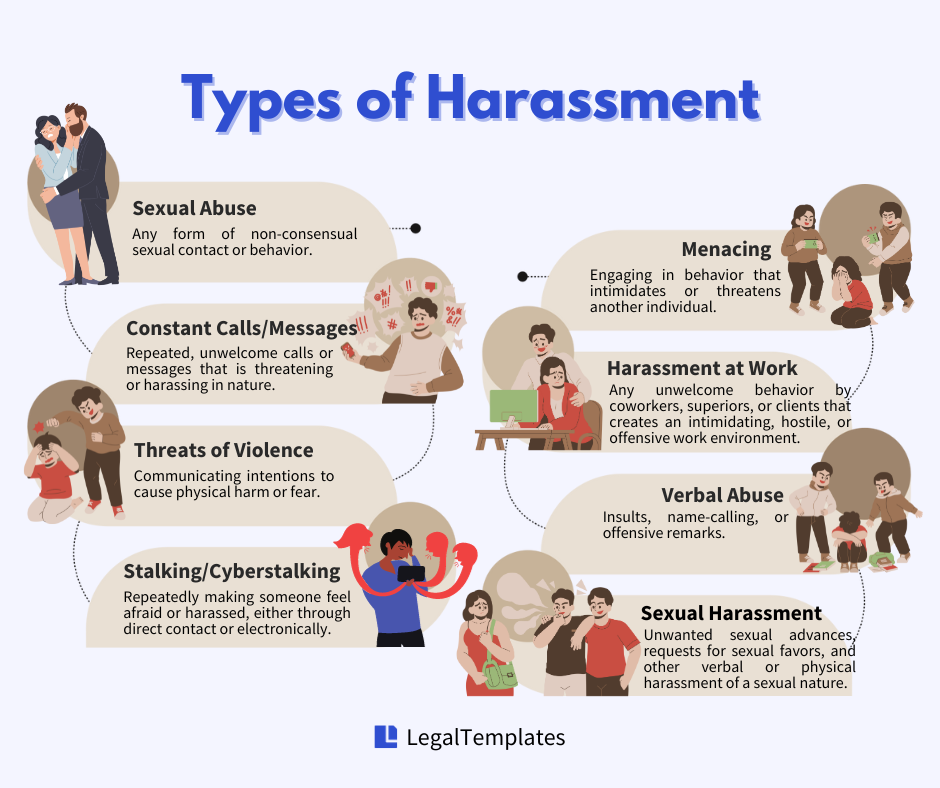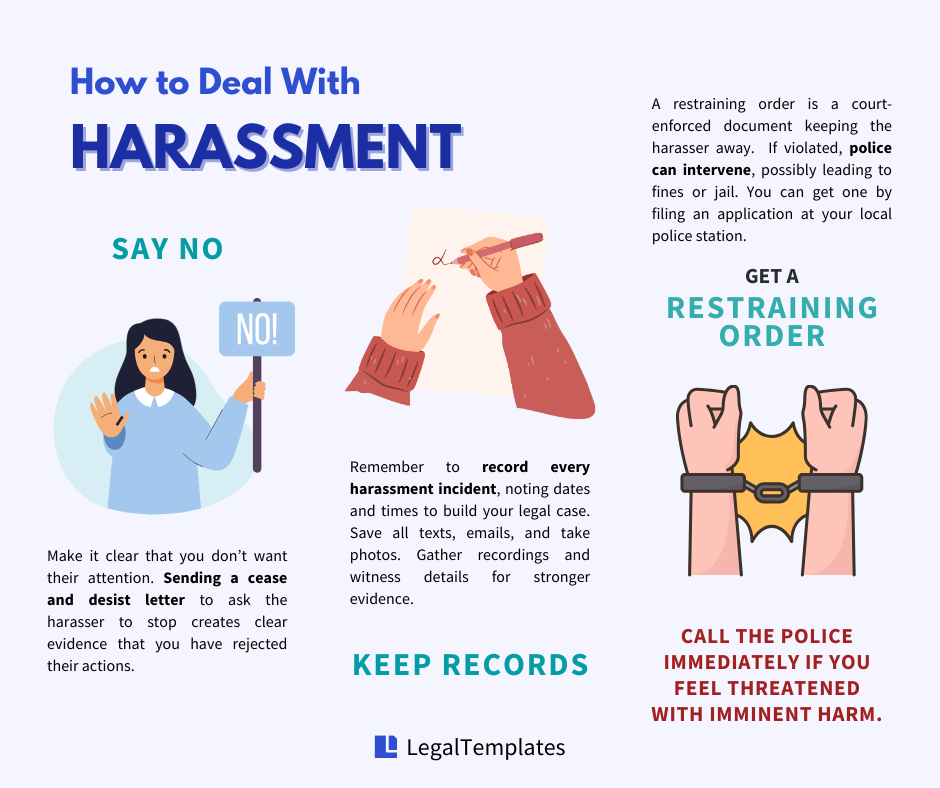

If someone is harassing you, you have a legal path toward protection and stopping the harassment. Legal remedies vary from place to place, but the path follows some general trends.
This article will give a brief overview of harassment, and types of harassment you can get legal help with, discuss how to stop someone from harassing you legally, and give you some other ideas that may help.
Harassment is a repetitive behavior that threatens, offends, or demeans the victim. Harassment must be uninvited, unwanted, and unwelcomed behavior. It often results in creating a hostile environment for the victim.

Types of harassment can include (but are not limited to):
Harassment is a crime, and the harasser may have to serve time in jail if convicted. You also have civil law remedies: a restraining order or possibly a lawsuit.
Keep in mind that intention is crucial for a harassment claim. Your harasser must intend to make you feel threatened or afraid. You can prove this if they continue their actions after you tell them to stop.
It is not enough that a person mistreats you. You must tell them to stop. If you tell them “no,” any following action has the intent to harass.

First, you can tell the harasser to stop calmly and clearly. Make it clear that you don’t want their attention.
Here are some ways to say no to a harasser:
A safer way to stop harassment is by getting the law involved to help you, from the police to the courts. This is the strongest and most official way to prevent harassment. You can do this immediately or after other efforts to solve the problem have failed.
Call the police immediately if you feel threatened with imminent harm. If you are uncertain, call the police. If you have a restraining order, call the police and have them enforce it. Your harasser may break other laws, and police can arrest them for those or the harassment.
Call 911 if it is urgent. Call the regular police phone line if not.
To get someone to stop harassing you, you can start with a cease and desist harassment letter.
If you are not in immediate danger, send the person a cease and desist letter and keep copies for yourself. How do you stop harassing texts and calls? It starts with a cease and desist letter. How do you stop someone from harassing you on social media? The same. This letter is a powerful tool, and it may stop harassment.
Telling your harasser to stop, in writing, creates an official record of you saying “no.” While this letter is not legally enforceable, it is clear evidence that you have rejected your harasser’s actions — which you may need later.
You need to build your legal case. Start a log or notebook where you write every incident of harassment and contact with its date and time. Do this as soon after the event as you can. Having clear evidence helps stop the harassment.
Keep all of your texts and emails. Photos and screenshots are also good evidence. Recordings, like messages left on your answering machine, are also evidence. If the harassment occurs in front of other people, record their names and phone numbers. You may need them to be witnesses later or to sign an affidavit of what they witnessed.
A restraining order (protection or no-contact order) is an enforceable legal document that stops a harasser from repeating problematic behavior. A court grants this order, and the police enforce it. You will need to serve notice to the harasser. How you may serve that notice to the harasser will vary by state. Once the harasser receives notice, the order goes into effect.
The judge tailors the order to the specific behavior of the harasser and also often requires that the harasser remain a certain distance (e.g., 50 feet) from you. It will limit the times, purposes, and methods of their behavior.
In most places, you start an application at the police station. In an emergency, you can sometimes get a temporary order if you prove you are in imminent danger. A restraining order is a beneficial legal tool to stop someone from harassing you.
The police can enforce the order, making the harasser comply. Note that some orders (stay away) are more accessible for the police to enforce than others (child support). They can also arrest the harasser and put them in jail, charging them with harassment or other crimes, if warranted.
Courts enforce that order by asking the court for civil contempt of court for violating the restraining order. If you can prove continued harassment after receiving notice of the order, they may have to pay a fine and/or serve time in jail. Criminal contempt is also a possibility. That process involves the police and prosecuting attorneys.
The laws about civil suits vary by state. You will need to check out those laws or get the guidance of a lawyer to see if you have a suit.
Civil rights laws bar most activities focused on a person because of specific characteristics they have. This can be gender, race, religion, age, and more. If you experience workplace harassment, especially sexual harassment, anti-discrimination laws may cover it.
Title VII of the Civil Rights Act of 1964 covers employees in the workplace. It only protects victims from companies, not individuals. You would have to claim that the company permitted harassment at work.
Remember, the harasser may face charges in criminal court. But that will happen separately (and faster) than a civil suit can.
You can also sue your harasser in civil court, but these cases are rare. In civil court, the case becomes about money lost. You can sue to get those costs back if you have hospital bills, lost work, or pain and suffering. The drawbacks are that these cases can take a long time, and if your harasser doesn’t have money, it will be hard to get them to pay a judgment.
A restraining order is a better way to control the actions of the harasser. It is how to get someone to stop harassing you.

Legal Content Editor
Josh Sainsbury is a business content editor at LegalTemplates. His background in a variety of industries allows him to create legal content that’s accessible and understandable for all audiences.
Take a stand against harassment now – create your cease and desist letter today to protect your peace and legal rights.